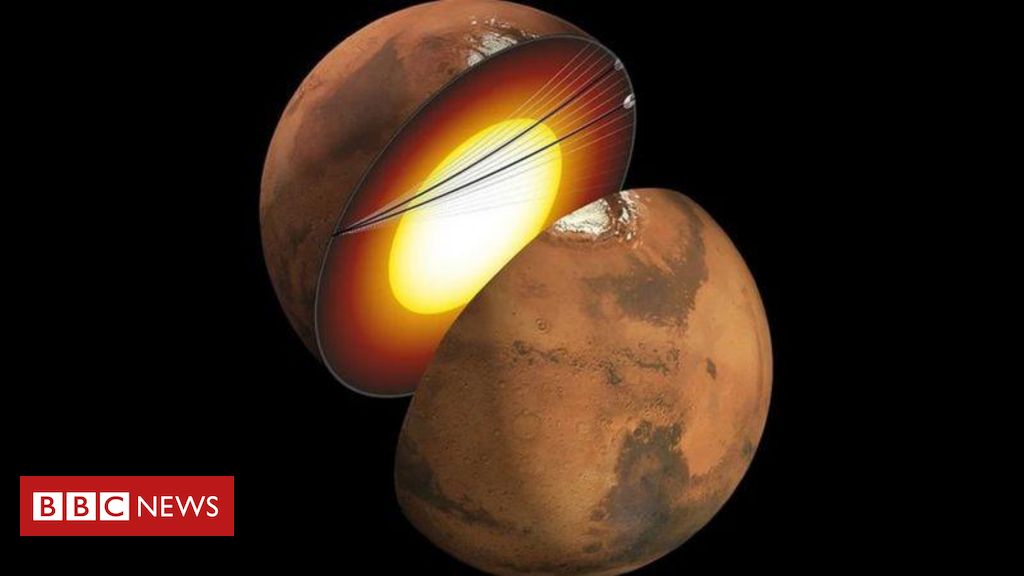How earthquakes first detected on Mars can help scientists better understand Earth
3 min read
credit, NASA/JPL Y Nicholas Schmeier
- author, article
- roll, BBC News World
For the first time, an international team of scientists has observed a series of seismic waves running through the Martian core.
These observations revealed that the Red Planet’s core is smaller and denser than previously estimated (with a radius of about 1,780 km to 1,810 km) – and consists of a completely liquid iron alloy with high proportions of sulfur and oxygen.
The discovery, made from measurements by NASA’s InSight probe, will provide a better understanding of how the planet originated and how it differs geologically from our own.
The research results have been published in the scientific journal Proceedings of the National Academy of Sciences.
Two major seismic events
In 1906, scientists discovered the Earth’s core for the first time, noting how seismic waves caused by earthquakes swayed as they passed through it.
“After more than a hundred years, we are applying our knowledge about seismic waves to Mars,” explained Vedran Lekic, assistant professor of geology at the University of Maryland in the United States, and co-author of the study.
The team was able to follow the evolution of two seismic events (one caused by an earthquake and the other by an asteroid impact), which occurred in the opposite hemisphere in which InSight is located.
Although the Insight mission ends in December 2022, researchers continue to analyze data collected by the spacecraft.
By measuring the time it takes to pass through the core and comparing it to mantle waves, and by combining this information with other seismic and geophysical measurements, the researchers were able to estimate the density and compressibility of the material passing through the waves. .
This shows that the Martian core is likely to be quite liquid, unlike Earth’s core, which has a liquid outside and a solid inner core.
magnetic field
On the other hand, the core of Mars has a high proportion of light elements mixed within it. About a fifth of its weight is made up of these elements (mostly sulfur, with smaller amounts of oxygen, carbon, and hydrogen).
This means that we are facing a much less dense core than Earth’s, and this difference indicates different conditions in the formation of the two planets.
“The properties of the core can serve as a summary of how the planet formed and how it dynamically evolved over time,” explained Nicholas Schmeier, a professor of geology at the University of Maryland, another co-author of the study.
The end result of these processes of formation and evolution is one that may or may not result in favorable conditions for life.
Since it does not have a magnetic shield to protect it, Mars is a planet hostile to life.
“The uniqueness of Earth’s core allows it to generate a magnetic field that protects us from the solar wind, which allows us to conserve water,” Shamir said.
In contrast, “the Martian core does not generate that protective shield, and without it conditions on the planet’s surface would be hostile to life.”
Although this magnetic field does not exist on Mars today, previous research indicates that it could have been present in the past, but lost certain elements and evolved in such a way that it went from a potentially habitable planet to a hostile one.
“Quantifying the amount of these elements in the planet’s core is important for understanding the conditions in our solar system when the planets were forming and how these conditions affected the planets that formed,” explained Doyeon Kim from the Federal Polytechnic School of Zurich in Switzerland. Another co-author of the study.
Studying the interior of Mars — the main goal of the InSight mission — will help researchers better understand how all the rocky planets, including our own, formed.

“Entrepreneur. Music enthusiast. Lifelong communicator. General coffee aficionado. Internet scholar.”

:strip_icc()/s04.video.glbimg.com/x720/11792055.jpg)

:strip_icc()/s03.video.glbimg.com/x720/11786998.jpg)



